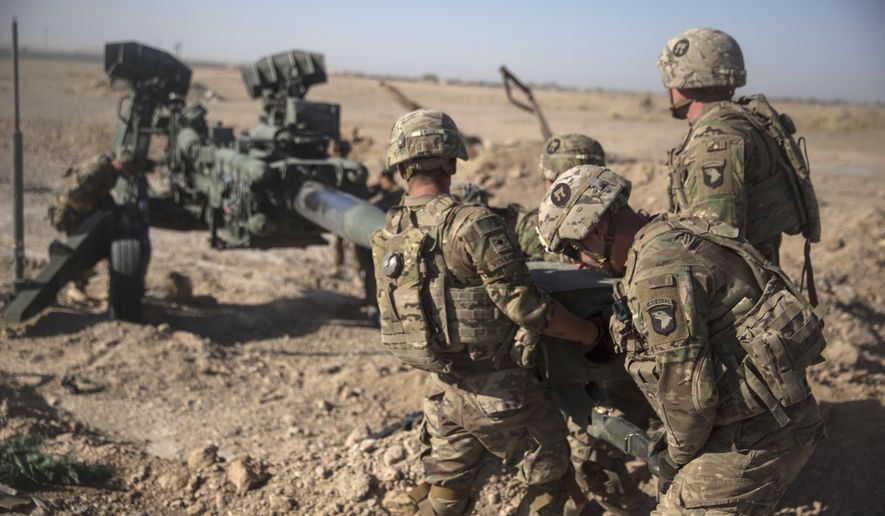President Trump’s clear desire to pull U.S. troops out of Afghanistan has given the Taliban the upper hand in power-sharing talks designed to end the country’s 2-decade-old civil war, the Afghanistan government’s chief negotiator said Thursday.
The February U.S.-Taliban deal called for a phased U.S. drawdown through the middle of next year if the Taliban made good on certain promises, but Mr. Trump sowed confusion last week with a tweet saying American forces “should” be home by Christmas. His national security adviser said the year-end goal was 2,500 troops, and the Pentagon said it was still operating on the original schedule.
The power-sharing talks have just begun, Taliban attacks on Afghan national troops continue, and there is no clear sign that the Taliban have fulfilled a promise to break with jihadi groups such as al Qaeda and the Islamic State, both of which are operating inside Afghanistan.
Abdullah Abdullah, who has led the Kabul government’s delegation in talks with the Islamist militant group, told the Financial Times in an interview published Thursday that Mr. Trump’s tweet has heightened the confusion about U.S. intentions and emboldened the Taliban at the negotiating table.
“Nobody has given any clarity” about the drawdown, Mr. Abdullah told the publication.
“If the U.S. withdraws, then [the Taliban] can come back by force,” he said. “They might see it in their advantage.”
In his surprise tweet last week, Mr. Trump said, “We should have the small remaining number of our BRAVE Men and Women serving in Afghanistan home by Christmas.”
The Taliban have long called a U.S. withdrawal one of their top priorities.
After Mr. Trump’s announcement, a Taliban spokesman said the looming exit of American forces from the “Islamic Emirate of Afghanistan” — the Taliban’s preferred name for the country — is a major step forward for the February peace deal.
“Islamic Emirate welcomes [Mr. Trump’s] remarks and considers it a positive step for the implementation of the agreement,” the spokesman said, but top Pentagon officials insist they are working under the original timetable and conditions set forward earlier this year.
Gen. Mark A. Milley, chairman of the Joint Chiefs of Staff, said this week that the U.S. is in the process of cutting its force in Afghanistan from roughly 12,000 service members at the beginning of the year to about 4,500. He stopped short of confirming discussions of a more rapid drawdown timeline.
Mr. Trump has made no secret of his desire to end the U.S. mission in “endless” conflicts such as Afghanistan. He has pushed to bring home U.S. forces in Syria, Iraq and, just this week, Somalia.
Cornerstone of a deal
A U.S. troop withdrawal was the cornerstone of the February peace deal between the U.S. and the Taliban. The deal did not include the government of Afghan President Ashraf Ghani but opened the door to the intra-Afghan negotiations that Mr. Abdullah is overseeing for Kabul.
Under the peace deal, the Taliban vowed to no longer harbor outside terrorist groups such as al Qaeda and the Islamic State and agreed to halt attacks on U.S. personnel.
But violence in Afghanistan has increased significantly, although defense and intelligence officials maintain that the Taliban have kept their promise to not harm U.S. or coalition forces.
Zalmay Khalilzad, the veteran U.S. diplomat who was Mr. Trump’s special envoy in dealing with the Taliban, said Thursday that the U.S. and Taliban have agreed to “reset actions” and strictly return to the terms of the February deal.
“Following several meetings General Miller and I had with the Taliban, we agreed to re-set actions by strictly adhering to implementation of all elements of the U.S.-Taliban Agreement and all commitments made,” Mr. Khalilzad tweeted.
He was referring to Gen. Austin Scott Miller, the commanding officer of the U.S. and NATO combat missions in Afghanistan.
Mr. Khalilzad said he expected the proposed reset to “significantly” reduce the number of Afghan casualties, which he acknowledged have cast a cloud over the deal.
“Attacks have been on the rise in recent weeks, threatening the peace process and alarming the Afghan people and their regional and international supporters,” Mr. Khalilzad said. “We will do our part and will monitor implementation actively. All parties must deliver on their responsibilities.”
Gen. Miller was even more forceful this week in his demands that the Taliban pull back as the talks proceed.
“The Taliban need to immediately stop their offensive actions in Helmand Province & reduce their violence around the country,” he said in a statement on Twitter. “It is not consistent with the U.S.-Taliban agreement and undermines the ongoing Afghan peace talks.”
His comments followed an intense weekend of violence that resulted in hundreds of casualties in Afghanistan’s southern Helmand province. The Afghan insurgents have long resisted a blanket cease-fire, calculating that the threat of violence is what drove Kabul and Washington to the bargaining table in the first place.
The Taliban launched a series of coordinated attacks across the province that forced more than 30,000 people to relocate, local authorities said.
Private analysts say the president’s comments could reinforce the Taliban’s determination to simply wait for the American and allied withdrawal and run out the clock on power-sharing talks.
“Without a U.S. military presence, the Kabul government’s already poor negotiating hand will be further weakened, and the regime left susceptible to bullying by the Taliban,” Marvin G. Weinbaum, director for Afghanistan and Pakistan Studies for the Washington-based Middle East Institute, wrote in analysis this week.
“On the battlefield, the somewhat improved capability and morale of the Afghan security forces are bound to suffer, especially after a complete withdrawal of U.S. air power.”
• Lauren Toms can be reached at lmeier@washingtontimes.com.




Please read our comment policy before commenting.